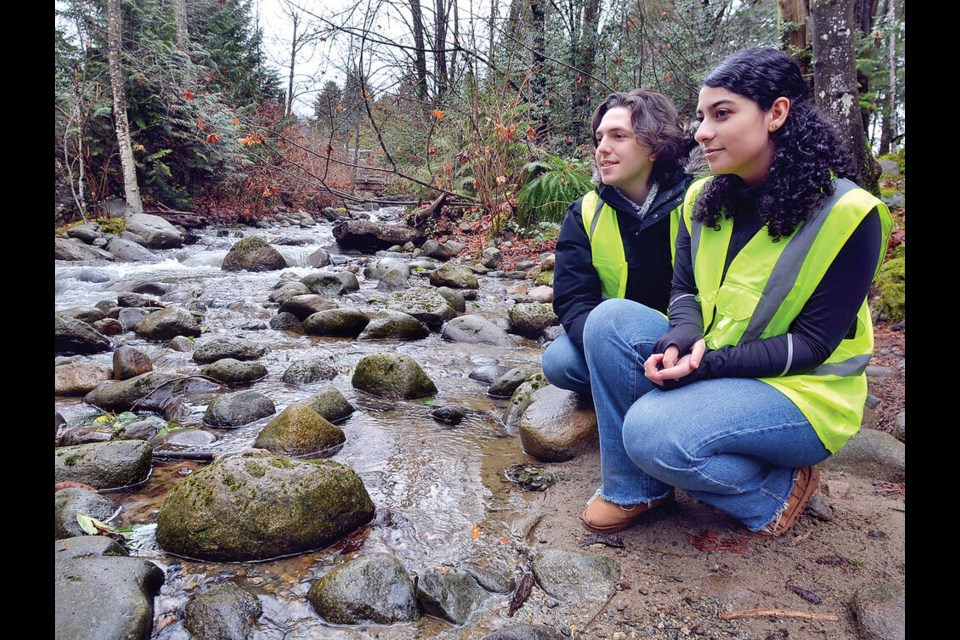The population of West Vancouver’s creeks is going through something of a change in demographics, according to the latest carried out by the West Â鶹´«Ã½Ó³»Streamkeeper Society and volunteer students from West Â鶹´«Ã½Ó³»and Sentinel secondaries.
For the last 16 years, the stewardship group has been partnering with students to trudge out to the tributaries of the Capilano River every fall, log the numbers of returning coho, chum, pink and chinook they spot and slit a few of the carcasses open to see if they had spawned.
The group reported their results to District of West Vancouverc council on Monday night.
This year, the students and Streamkeepers notched 587 sightings – mostly coho and chum – on the Brothers and Hadden creek systems, a number that has been rising steadily , although still down from the 2018 peak of 687.
Curiously though, there has been a noticeable shift in the species showing up. A decade ago, chum salmon would regularly make up 75 to 90 per cent of the fish documented in the creeks. In 2023, coho outnumbered them for only the second time since the program began.
“This year was the second best year for coho and the second worst year for chum,” said Meha Farrokhi, student statistician on the 2023 survey.
Streamkeepers past president John Barker said they can only speculate as to why the makeup of fish in the creek shifted so much. It could be related to successful spawning the year they hatched, the conditions the creeks faced when the eggs were in the gravel, the availability of food for juveniles in the ocean, level of predation by seals and other sea life and commercial fishing.
Fisheries and Oceans Canada scientists were predicting a good year for coho returns, Barker said, and that seems to be bearing out in creeks across the province.
Perhaps ironically, the high coho count in West Â鶹´«Ã½Ó³»came in the same spawning season as a mass fish kill that left dozens of the species dead. In late October, Barker and the students discovered carcasses along the banks of the creeks, too early to have died naturally after spawning. The cause was almost certainly toxic stormwater runoff carried from the roadsides – specifically 6PPD-quinone, a chemical additive in car tires, that is specifically lethal to coho.
In the United States, tire manufacturers and regulators are facing pressure from First Nations, state governments and lawsuits to phase out the chemical. Locally, Barker said volunteers from the group are already in discussions with district staff about building bioswales or rain gardens, which have been shown to naturally filter out toxins at likely entry-points to the creeks.
Thankfully, most of the coho the students counted in the survey arrived after the toxic plume washed out of the creek system.
Beyond fresh stats on the health of local creeks, student statistician Jeffrey Jackson told West Â鶹´«Ã½Ó³»council the spawner survey delivered an important awakening for the 72 volunteers.
“Our lives, over the decades, have turned into a struggle away from nature,” he said. “[This] enabled us to become connected with nature again. This amazing opportunity allowed us to slow our fast-paced lives, to take action towards a meaningful cause. We saw the environmental impacts of our society’s actions and how aspects such as climate change or chemicals used in car tires can affect the ecosystem.”
Barker said that is the real value of salmon spawner survey – creating a new cohort of allies for salmon on dry land every year.
“I’ve often said to them, you know, you’re going forget a lot of things that went on in life during your secondary school years. You won’t forget the days that you saw salmon in a creek in an urban environment, like we have,” he said. “Seventy-two kids are a lot smarter about fish than they were in August last year.”


